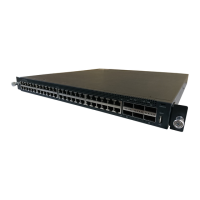User’s Guide FUJITSU PSWITCH
December/2018 115
increases its rate voluntarily to recover lost bandwidth and probe for available
bandwidth. The switches only support CP algorithms.
3.1.8.1.3. QCN (Quantized Congestion Notification)
Quantized Congestion Notification (QCN) supports congestion management of
long-lived data flows within a network domain by enabling bridges to signal
congestion information to end stations capable of transmission rate limiting to
avoid frame loss. This mechanism enables support for higher-layer protocols that
are highly loss or latency sensitive. QCN helps to allow network storage traffic, high
performance computing traffic, and internet traffic to coexist within the same
network.
The QCN’s configuration can be carried by LLDP protocol, but the switches doesn’t
support auto defense mode. So switches can send LLDP message with QCN
information, and there is no any action for receiving LLDP messages. Switch just
displays mismatch information about LLDP message.
3.1.8.1.4. ETS (Enhanced Transmission Selection)
Enhanced Transmission Selection (ETS) is defined in the 802.1Qaz standard. ETS
introduces a new 4-bit field called the Priority Group ID (PGID). ETS allows one or
more priorities to be assigned to a PGID. Each PGID is allocated a percentage of
available bandwidth on the link. Once allocated, a PGID may only use the available
bandwidth up to the maximum percentage allocated.
The CoS Queuing feature allows the switch administrator to directly configure
certain aspects of the device hardware queuing to provide the desired QoS
behavior for different types of network traffic. The priority of a packet arriving at an
interface can be used to steer the packet to the appropriate outbound CoS queue
through a mapping table. CoS queue characteristics such as minimum guaranteed
bandwidth, transmission rate shaping, etc. are user configurable at the queue (or
port) level.
ETS may be used standalone with DCBX. However, all ETS/PFC/CN would be
deployed in the data center domains. DCBX protocol advertises the ETS
configuration to the peers and receives the ETS configuration from the peers. Based
on the implementation, the switches can act upon the received ETS data from the
peers.
Enhanced Transmission Selection (ETS) allows Class of Service (CoS) configuration
settings to be advertised to other devices in a data center network through DCBX
ETS TLVs. CoS information is exchanged with peer DCBX devices using ETS TLVs.

